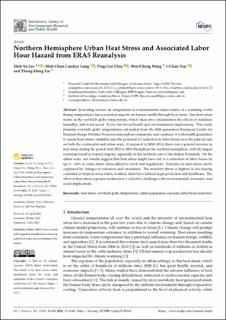| dc.contributor.author | Lee, Shih-Yu | |
| dc.contributor.author | Lung, Shih-Chun Candice | |
| dc.contributor.author | Chiu, Ping-Gin | |
| dc.contributor.author | Wang, Wen-Cheng | |
| dc.contributor.author | Tsai, I-Chun | |
| dc.contributor.author | Lin, Thung-Hong | |
| dc.date.accessioned | 2023-03-07T12:43:29Z | |
| dc.date.available | 2023-03-07T12:43:29Z | |
| dc.date.created | 2022-09-27T11:04:10Z | |
| dc.date.issued | 2022 | |
| dc.identifier.issn | 1661-7827 | |
| dc.identifier.uri | https://hdl.handle.net/11250/3056456 | |
| dc.description.abstract | Increasing surface air temperature is a fundamental characteristic of a warming world. Rising temperatures have potential impacts on human health through heat stress. One heat stress metric is the wet-bulb globe temperature, which takes into consideration the effects of radiation, humidity, and wind speed. It also has broad health and environmental implications. This study presents wet-bulb globe temperatures calculated from the fifth-generation European Centre for Medium-Range Weather Forecasts atmospheric reanalysis and combines it with health guidelines to assess heat stress variability and the potential for reduction in labor hours over the past decade on both the continental and urban scale. Compared to 2010–2014, there was a general increase in heat stress during the period from 2015 to 2019 throughout the northern hemisphere, with the largest warming found in tropical regions, especially in the northern part of the Indian Peninsula. On the urban scale, our results suggest that heat stress might have led to a reduction in labor hours by up to ~20% in some Asian cities subject to work–rest regulations. Extremes in heat stress can be explained by changes in radiation and circulation. The resultant threat is highest in developing countries in tropical areas where workers often have limited legal protection and healthcare. The effect of heat stress exposure is therefore a collective challenge with environmental, economic, and social implications. | en_US |
| dc.language.iso | eng | en_US |
| dc.publisher | MDPI | en_US |
| dc.rights | Navngivelse 4.0 Internasjonal | * |
| dc.rights.uri | http://creativecommons.org/licenses/by/4.0/deed.no | * |
| dc.title | Northern Hemisphere Urban Heat Stress and Associated Labor Hour Hazard from ERA5 Reanalysis | en_US |
| dc.type | Journal article | en_US |
| dc.type | Peer reviewed | en_US |
| dc.description.version | publishedVersion | en_US |
| dc.rights.holder | Copyright 2022 The Author(s) | en_US |
| dc.source.articlenumber | 8163 | en_US |
| cristin.ispublished | true | |
| cristin.fulltext | original | |
| cristin.qualitycode | 1 | |
| dc.identifier.doi | 10.3390/ijerph19138163 | |
| dc.identifier.cristin | 2055803 | |
| dc.source.journal | International Journal of Environmental Research and Public Health (IJERPH) | en_US |
| dc.identifier.citation | International Journal of Environmental Research and Public Health (IJERPH). 2022, 19 (13), 8163. | en_US |
| dc.source.volume | 19 | en_US |
| dc.source.issue | 13 | en_US |

